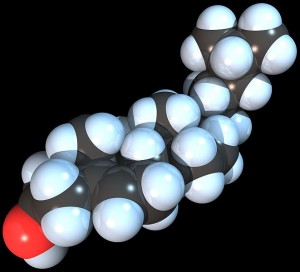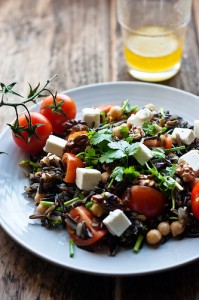The Mediterranean Diet – A Natural Way to Lower Bad Cholesterol
This week, we’re pleased to publish an article by Dr. Enrico Fortie, nutrition and weight loss coach. As residents of Catania, Sicily, Dr. Fortie and his wife’s experiences in healthy Italian eating and blogging inspired them to write The Mediterranean Diet Menu Book, which discusses the age-old nutritional practices that are followed by some of the healthiest people on earth.
——————
Having high cholesterol is something no one wants to hear from their doctor, yet it is becoming more commonplace every day. Having high levels of LDL, the “bad” type of cholesterol, can block arteries and increase risk for heart disease and stroke. There are many variables that put an individual at a higher risk for having excessive levels of cholesterol in their blood stream. Understanding what cholesterol is, and how diet impacts cholesterol, can help people live longer and healthier lives.
What is Cholesterol?
 Cholesterol is a fatty substance found in the blood that can stick to the walls of the blood vessels. There are two distinct types of cholesterol, low-density lipoprotein, or LDL, and high-density lipoprotein, or HDL.
Cholesterol is a fatty substance found in the blood that can stick to the walls of the blood vessels. There are two distinct types of cholesterol, low-density lipoprotein, or LDL, and high-density lipoprotein, or HDL.
LDL is the bad brother of HDL. When high amounts of LDL are found in the bloodstream it can cause blockages in the arteries and puts people at greater risk for heart attack. HDL is the good brother. High HDL levels in the bloodstream will actually reduce the risk of heart disease because its job is to keep the LDL under control. It removes the fatty LDL and keeps the blood vessels healthy thus preventing atherosclerosis.
Both LDL and HDL are found in animal based foods. Fruits and vegetables do not contain either type of cholesterol. Because of this, a diet high in saturated fats is one of the main risk factors for high cholesterol. Other risk factors for high HDL cholesterol levels are diabetes, obesity, sedentary lifestyle, and family history.
A simple blood test can determine cholesterol levels. Combined, normal HDL and LDL levels in the blood should not be more than 200 milligrams. Anything over 240 milligrams is considered high cholesterol. Ideally LDL alone should be less than 130 and HDL alone should be over 40. Dividing the LDL count by the HDL count will provide the ratio. For men, the ratio should be below 4 and women below 3.5. Studies have shown that bringing the ratio below 2.8 can actually reverse heart disease.
The Mediterranean Diet
The Mediterranean diet is one of the healthiest ways to eat, and can significantly lower cholesterol levels. It does so by avoiding foods high in saturated and trans fats, instead opting for food options low in cholesterol such as low fat dairy products, fruits, vegetables, whole grains, legumes, and egg whites.
The diet is designed to increase metabolism, reduce hunger and cravings while helping people to lose weight and reduce risk of disease and illness.
The Mediterranean diet can be outlined by food groups and how often to consume certain foods.
You should use the following as a guideline for daily, weekly and monthly consumption of food.
Daily Consumption:
- At least six glasses of water
- Fresh fruit and vegetables with every meal: Oranges and berries should be eaten frequently because they contain helpful antioxidants. Fruit can be eaten as a dessert.
- Whole grains, bread, pasta and potatoes
- Nuts and legumes: Nuts provide protein and monounsaturated fats, but should be eaten in moderation because they are high in calories. Legumes such as beans are high in protein and fiber and should be a diet staple.
- Olive oil should be the main source of fat. It can be used in cooking or as a salad dressing.
- Cheese and yogurt.
Weekly consumption:
- Fish provide necessary omega-3 fats and should be consumed two or three times per week.
- Poultry
- Eggs
Monthly consumption:
Red meat should be limited and only eaten once or twice a month.
Instead focus on white meats such as fish and poultry and other protein sources such as nuts and beans.
Sample Menu
There are many healthy foods that can be consumed while eating a Mediterranean style diet. Meals should be small and healthy snacks should be incorporated throughout the day to prevent hunger and binging on unhealthy foods. A sample day would look like:
Breakfast: Yogurt with fruit and granola
Lunch: Turkey sandwich on whole grain bread, apple, tortilla chips and salsa
Snack: Hummus and pita wedges
Dinner: Whole grain pasta with meatballs and tomato sauce, salad with olive oil and lemon, glass of red wine
Snack: Fresh berries with whipped topping or honey.
Diet is an important factor to consider when trying to reduce your LDL cholesterol. Eating foods low in saturated fats is an important aspect to consider if you want to reduce your LDL numbers. The Mediterranean diet is low in saturated fats (low red meat) and rich in cholesterol lowering foods like olive oil and foods rich in soluble fiber (i.e. beans or other legumes). These foods are rich of unsaturated fats and play an important role in reducing LDL and boosting HDL.
Join Our Community
Archives
- January 2023
- December 2022
- September 2022
- August 2022
- June 2022
- May 2022
- April 2022
- March 2022
- February 2022
- January 2022
- December 2021
- November 2021
- October 2021
- September 2021
- August 2021
- July 2021
- June 2021
- May 2021
- March 2021
- September 2020
- August 2020
- July 2020
- June 2020
- May 2020
- April 2020
- March 2020
- February 2020
Subscribe

Sign up to receive FREE toolkit
From Dr. Hyman, #1 NY Times & Amazon Author
We never spam or sell your e-mail




Follow Our Every Move